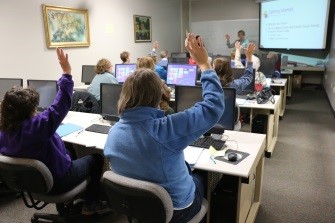5 Videos, 1 Math Problem: Accessibility + Support = Access, Comprehension, Progress, Achievement
Here are five video shorts to inspire every teacher to enrich learning by:
- Turning on accessibility features built into school and student devices
- Electing usability and assistive tech supports in the software that a school owns
- Downloading free accessible digital materials and tools **
- Bringing the benefits now, not later, of free accessible learning materials from statewide AEM/AIM programs as soon as special education students struggle with traditional books in print or inaccesible digital text and fall behind their peers
** In Virginia, all students can download and use Read:OutLoud 6 at no cost thanks to AIM-VA. This simple-to-use text reader from Don Johnston, Inc. makes learning materials usable so students take in and understand text.
Video 1
"Leveling the Playing Field with Assistive Technology," (2016, 2:08 min.), embedded above, comes from the PATINS Project, AIM-VA's counterpart in Indiana. View a path to progress that the PATINS Project staff and a teacher put in place for a Terre Haute student with dyslexia. Tools used yield data to drive instruction.
Other Paths To Progress:
Video 2
"Accessibility and PhET" (2016, 1:57 min.) shows the work ongoing in the PhET Interactive Simulations project so all students can use and learn with STEM simulations, including students with disabilities. New accessibility features are in development, and coming soon to PhET simulations!
Will those in the future be "born accessible?" Learn more about the research, design, and development by exploring accessible simulation prototypes.
Video 3
Current AEM Center Co-Director Joy Zabala and others offer wisdom and tips for supporting students to use accessible instructional materials (AIM). In "AIM Tips Part I: Introducing AIM to Students" (2011, 4 min.) it is not enough to place students in general ed classrooms. Students need to learn there!
Accessible learning materials are proven to help students stay on grade, meet individualized education program goals, and maintain their self-esteem.
Video 4
"Understanding Accessibility in Digital Learning Materials: Simply Said" (2015, 6:42 min.) was a joint project of The National Center on Accessible Instructional Materials and PACER Center. This fully captioned video explains that not all digital learning materials are accessible. Learn why teachers must increase the demand for accessible materials in order to encourage publishers and developers to make accessibility a priority.
Video 5
"Eye to Eye: Radford University (Virginia) shows the work of a national nonprofit mentoring organization that pairs students who have learning disabilities and attention deficit hyperactivity disorder (LD/ADHD) with college and high school mentors who have been similarly labeled. This film reminds all educators about essential social-emotional learning and value of using the arts to keep struggling students on course academically. Check out the work of the Eye to Eye program in your state.
We Are AIM-VA
Accessible educational materials (AEM) help to create access to the curriculum for students with dyslexia, learning disabilities, vision or physical challenges, and others. A federally funded AEM program in every state assures that books in alternative formats are provided free of charge to eligible students with disabilities whose education teams take action. The AEM program operates under a legal exception to federal copyright law. Check out the AIM-VA home page to learn more about eligibility in Virginia. In other states, contact a special education teacher, a school administrator or download a list of AEM state contacts.![]() .
.
Follow AIM-VA on Facebook ![]() , Pinterest
, Pinterest ![]() , and Twitter at @AIMVirginia.
, and Twitter at @AIMVirginia.![]() and/or follow me @aimnoncat.
and/or follow me @aimnoncat.![]() . Subscribe to AIM-VA's new monthly newsletter. Sign up here.
. Subscribe to AIM-VA's new monthly newsletter. Sign up here.







